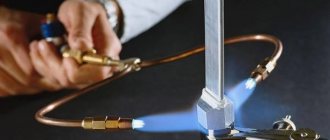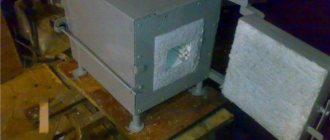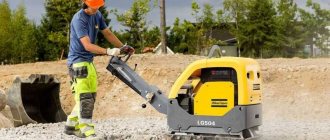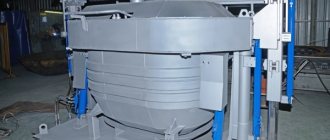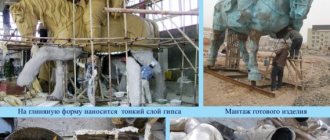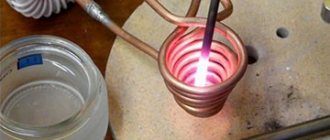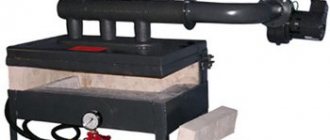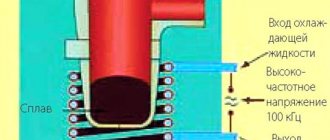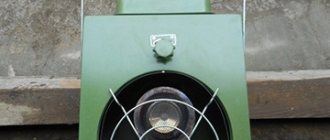Heating to high temperatures is a necessary component of many technologies that are used in home creativity, commercial activities and industrial production. Factory heating devices are highly efficient and, accordingly, have a price that not everyone can afford. A do-it-yourself muffle furnace for hardening metal can be assembled at minimal cost with excellent performance characteristics. To achieve the desired result, you should familiarize yourself with the device, operating principle and possible options for assembling a 1000 degree oven with your own hands.
What is a muffle furnace
A muffle furnace is a heating device designed to heat something to a given temperature.
A muffle furnace is a thermal device designed to heat materials to a given temperature. It consists of a heating chamber and a capsule (muffle) into which the object being processed is placed.
The scope of application of the devices is quite extensive:
- Laboratory analysis. The properties of many minerals appear at high temperatures.
- Blacksmith craft. Heating of workpieces while maintaining their shape and the absence of scale.
- Hardening of metal. Heat treatment changes the crystal structure, increasing strength and rigidity.
- Fuse. Isolation of the required substance from heterogeneous raw materials. This is how ingots of aluminum, gold and silver are obtained.
- Annealing. Helps achieve a given microstructure when creating parts from several components.
- Burning. Giving objects the necessary properties, such as hardness, presentability, resistance to moisture and chemicals.
- Heat treatment. Removing water, acid, oils, and other liquids from a substance to ensure complete drying.
- Vacation. Removing internal stresses after melting or hardening, achieving plasticity.
- Ashing. Removing foreign impurities by burning them. Determination of the presence of minerals in the alloy under study.
Using the functions of the devices allows you to obtain beautiful ceramics, souvenirs, and unique metal products.
Types of muffle furnaces
Gas muffle furnace
Heating devices differ in several indicators, which does not particularly affect their performance characteristics.
Among specialists, a classification into certain categories is accepted.
Energy Source:
- electricity;
- natural gas;
- coking coal;
- firewood.
Content protection type:
- in the air (mechanical only);
- gas environment (argon, helium, nitrogen);
- vacuum.
Housing design (loading method):
- vertical;
- horizontal;
- detachable (bell-type).
Heating level:
- moderate;
- average;
- high;
- ultrahigh.
There is a gradation based on structural, refractory and electrically conductive materials used in the production of stoves.
Control block.
Connections on the rear side of Ш4501. For those who don’t understand, the wiring diagram is once again shown on the plastic cover.
Please pay attention - the compensation wire must go all the way to the terminal block with the compensation coil. Such fittings for indicator lamps are no longer produced, so I recommend using modern types XB2-EV161
They come in red, yellow, green, white and blue. Electrical diagram of the control unit. If you do not find a sufficiently powerful toggle switch for turning on the control unit, then place it after the contacts of the PE23 relay. The relay comes complete with the Sh4501 device. The power of the relay contacts is 500 VA in the alternating current circuit. The diagram does not show - I have 3 groups of contacts in parallel, so the switching power is up to 1500 VA. The diagram has been corrected - the TLZ lamp is suitable for normally closed contacts, TLO for normally open ones.
Implementation of installation of the control unit in this box. The regulator is tucked into the front of the skis. The connector is connected (on the right). The relay is mounted on the back cover from the inside.
Furnace assembly. Back view. As you can see, the thermocouple wires and heater leads are simply cooled in air, without any frills. The heater wires are connected through a terminal block, preferably with a ceramic base. I recommend using a ceramic socket from a socket or a ceramic lamp socket. The thermocouple leads are also through the terminal block. A piece of compensation wire corresponding to the graduation is connected to the same terminal block contacts. If this is an ordinary wire, then the device will lie on the value of the temperature difference between this terminal block and the rear panel of the Sh4501 with the measuring coil. An overhead socket for connecting the load is mounted on the outside of the back cover, and a terminal block for connecting a thermocouple is mounted on the back cover of the muffle box. This allows you to use this control unit not only with this muffle, but also for temperature control in your other devices. It is enough to screw a thermocouple of this calibration to the terminal block and insert the plug into the socket.
A little about a homemade thermocouple. For the final budget of our furnace, I used a homemade thermocouple with XA calibration. I prefer homemade thermocouples not out of greed, but simply because they have less inertia compared to factory ones. Although there is a risk of burning the regulator input circuits. I will not dwell in detail on the manufacture of such a thermocouple, because this process is well covered in the literature (Bastanov. 300 practical tips) and on the Internet.
The material was cores from compensation wire of HA calibration. The ends are welded with a tungsten electrode in an argon atmosphere. If you weld it this way, it’s weak, whereas it’s described in books in graphite with borax using a powerful transformer. Then the thermocouple is inserted into a ceramic two-channel MCR tube. At this point, sorry, you'll have to fork out the cash.
Heating chamber assembly. The wall has been finished, the cracks have been sealed. Then some excess putty is applied around the mouth of the muffle. Then it is covered with polyethylene and the lid is closed. The relief of the lid is imprinted on the putty. The polyethylene is removed and the whole thing is dried. The gaps between the cover and the chamber are minimal.
Muffle assembled. After laying the spiral, it is coated with the same composition that the muffle is made of. The ends of the spiral are secured with a loop made of glass tape with mica. Don't forget to put a mounting rod under the spiral. When the muffle dries, the rod is removed and a hole remains for the thermocouple.
Muffle without strapping
Pay attention to the grooves on the corners of the muffle. They are so that the spiral does not move during coating
At the bottom there is a groove for a thermocouple. The thermocouple should be in close proximity to the coil.
- Equipment Melting crucible electric furnace
- Vacuum generator (small)
- Vacuumator (large)
- Wax injector
- Wax injector small
- Compressor-vacuum pump
- Electric muffle furnace (small)
- Ball screw muffle furnace
- Oven temperature controller
- Gas muffle furnace
- Gas crucible furnace
- Drilling machine - mini lathe
- "Third Hand"
- Unstabilized for drills
Muffle furnace design
For all their versatility, muffle furnaces have a relatively simple design. The peculiarity of the devices is the use of special components that can withstand temperatures up to 2000ºС.
The products consist of the following parts:
- Frame. The shape and size are determined by the volume of tasks assigned to the device. It is mandatory to install a valve to bleed gases released during the processing process. The body can be metal or made of modern polymers.
- A heating element. This could be a coal or wood stove, TEN, or gas burner.
- Internal lining. The walls are covered with ceramic plates, and in artisanal conditions with fireclay bricks.
- Door. There are various models, from the simplest ones with a handle to modern ones, which use a lever system that eliminates contact with hot parts.
- Communications. Depending on the type of product, this is a power cable, a high-pressure cylinder and hose, or a mechanical blower.
- Muffle. Chemical ceramic capsule of stationary or replaceable type.
- Controls. The devices can be equipped with a light and sound alarm, an interface for communication with a computer, a recording device, and a thermostat-programmer.
Depending on the production cycle, the furnaces are turned on for a certain period of time or operate continuously with periodic replacement of filled muffles.
Types and conditions of processing of raw materials
Muffle furnace for hardening metal
In the process of processing workpieces, various processing methods can be used in terms of time and degree of heating, duration and cooling methods. One or another method of protecting workpieces can also be used.
The material processing technology used is as follows:
- Ceramics. Open, 600ºС.
- Porcelain. Open, 800ºС.
- Faience. Open, 1000ºС.
- Majolica. Open, 1200ºС.
- Hardening of cutting metal products. Argon 800ºС.
- Melting of non-ferrous metals. Argon 800-1200ºС.
Deviation from the instructions leads to deterioration in the quality of the finished product or damage to the loaded substance.
Making a homemade muffle furnace
To make a stove you will need a grinder. A
do-it-yourself muffle furnace is made using the following tools:
- screwdriver;
- roulette;
- hammer;
- level;
- soldering iron;
- pliers;
- Bulgarian;
- electric drill.
After preparing the necessary equipment, you need to make a drawing and, based on it, start preparing the components.
For a homemade housing, you can use faulty or old household appliances that have been idle for a long time - a microwave, oven, freezer. All fillers that can melt and burn under high heat must be removed from the casing. If there are no such objects at hand, the body is made independently. To do this, a steel sheet with a thickness of at least 2 mm is taken and welded into a rectangular or round structure. It is advisable to use a gas cylinder or a steel pipe with thick walls as a ready-made template. To protect against corrosion and give the product a presentable appearance, it must be coated with fire-resistant paint.
The stove is made from fireclay clay mixed with sand and asbestos
Another way to make a stove is to model it from a mixture of fireclay clay, sand and fluffed asbestos. A wax mold is first made, on which protrusions for the legs are made. A mixture of plasticine consistency is evenly distributed over the pattern, then dried at room temperature for two weeks. Then the wax is melted with a hairdryer, and the mold is calcined in coals for 6 hours.
If there is a transformer substation nearby, the task is greatly simplified. There, for a reasonable fee or for nothing, you can get tubes from fuse links. The products are made of a durable substance and are designed to withstand extreme heat and temperature changes. All that remains for the master is to work a little with a grinder and fireclay clay.
The next item will be the installation of the heating element and thermostat (control unit sensors). Two gas burners or electrical elements are mounted on the furnace body. The burners are installed from below and from above. Electric heaters are fixed depending on their configuration. The wire is wound in a spiral, TENs are placed on the sides, and if heat of 1500ºC or higher is needed, then on the floor and vault. Ground must be provided to prevent electric shock to the employee. The heaters are then covered with a steel casing, in which a hole is made for the air valve.
Thermal insulation is applied to the outer casing as tightly as possible to its surface. The best option today is considered to be basalt wool in rolls. To close the camera securely enough, a layer 20 mm thick is enough. The thermal insulation can be secured with aluminum tape or copper wire wound in frequent turns. The finished structure is placed in the housing if such a stove model is selected.
The penultimate step before installing the electronics is making the cover.
Process sequence:
- Fitting, fastening and adjusting hinges. Screw or wedge locking devices are used.
- Fireclay bricks are taken and cut to size. The edges are ground down to ensure the lid closes.
- A solution is prepared from clay, sand and cement in a ratio of 1:3:1. It is applied to the door, the brick is pressed tightly, and pressure is placed on top.
- After drying, the cover is hung in place and the joints are sealed. Heat-resistant silicone is used, applied around the perimeter of the sash.
You can use the device after 2-3 hours.
The simplest option for arranging a muffle furnace for firing ceramics is a combination of a powerful electric stove and medical ceramics. Fireclay should be placed under the vessel to ensure even distribution of heat. The power is regulated by the standard tile device.
Principle of operation
Furnaces for firing ceramic products, regardless of the type of fuel, operate according to a certain scheme:
- air-dried clay products are placed in the cavity for placement. We place large items at the bottom and place the rest of the toys or plates like a pyramid;
- The oven door closes tightly and the temperature in the oven gradually increases. First we bring it to 1500-2000;
- after preliminary heating of the parts for 2 hours, the temperature rises to 3500-4000;
- after 2 hours we increase the temperature by another 2000 and so bring the heating to 9000;
- turn off the heating devices or extinguish the flame in the oven and leave the products to cool gradually. The door must always be closed until the finished ceramic is removed.
Uniform and gradual cooling makes ceramics strong and durable. After the entire firing stage, you can begin to apply a layer of glaze or other decorative finishing.
Important! Using an oven for baking polymer clay, we achieve volume of products and give them additional attractiveness. A flower bouquet that has been hardened will look like a real one.
Safety precautions
The handles are made of dielectric plastic.
The muffle furnace is a potentially dangerous device that requires compliance with the following safety measures:
- the turns should not touch each other, otherwise a short circuit will occur;
- for putty you can use clay or heat-resistant silicone;
- handles must be made of dielectric plastic.
When working with the stove, you must use effective ventilation.
Make it yourself or buy it
A muffle furnace is a multifunctional device that has found its application in laboratories, production and art. The cost of even small options is very high, so for ordinary purposes you can use homemade options.
Electric muffle furnace
